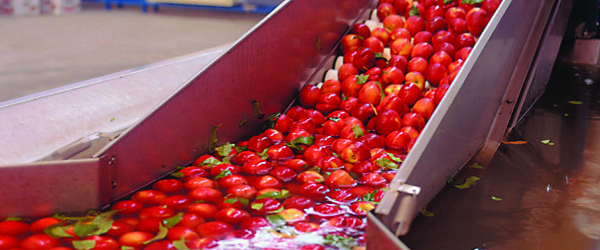Posted 1 July 2003

Consumers expect processed foods to be tasty and nutritious, affordable and safe. To meet these expectations, food contact equipment has to be hygienic and productive.
A manufacturer’s wish list for its food processing components might read like this:> durable, with easy release and easy-to-clean surface
> inert, non-toxic and non-contaminating
> corrosion-resistant and non-degrading
> suited to continuous, in-line sanitation and cleaning
> impervious and non-absorbent to food products, odours, stains and colourings
> economical, reliable and safe over its entire working life
> temperature versatile and highly conductive, eg from cooking to cryogenic temperatures
> smooth, seamless, one-piece construction
> removable and replaceable
> repairable/maintainable by existing technologies.
At first sight this seems too much to ask of any single product, but stainless steel conveyor belts fit the bill.
 Unique Belting for the Food Industry
Unique Belting for the Food Industry
Continuous carbon steel belts were introduced into US and European bakeries in the 1920s and are today used primarily for processing baked goods. ASSDA member Sandvik launched a stainless steel belt in 1931 to withstand wet or corrosive conditions in the food and chemical industries.
The product found a foothold in the market and increasingly since the 1960s, the stainless steel belt has moved from being a simple food conveying medium to a processing platform. Now ranging in width from 200mm up to several metres and in solid or perforated forms, stainless belts are used in cooling (chilling, freezing, pastillating, freeze drying), heating (drying, roasting, blanching, steaming) and mass transfer (dehydrating, aeration, dewatering) for value added processing of foods. Stainless provides superb temperature versatility, from -200ºC (in cryo-freezing belt tunnels) up to +300ºC (high-temperature cooking tunnels). It can be continuously sanitised during operation using zoned washing boxes fitted to the lower strand of the belt.
The smooth, continuous stainless belt is also versatile in the types of food product it can convey and process – powdery, granular, fragile, bacterially-sensitive, sticky, viscous, sharp, pasty, slurry, runny, chunky, awkward, hot, oily … you name it, chances are it can be handled by the stainless belt. Accordingly, the stainless belt has found application over wide areas of wet food processing – for dairy, confectionary, meats, seafoods, pet foods, beverages, snack foods, frozen foods, fruit, vegetables and nuts.
Quality stainless belts for the food industry are solid, continuous, smooth and seamless and free of links, hinges, pins, weaves or anything that could trap food residues, dirt and bacteria.
Textured Stainless Brings Increased Efficiency
Case Study 1 - GP Graders
Melbourne-based GP Graders has captured the attention of fresh fruit packers around the world with its innovative grading and packing lines which utilize textured stainless by ASSDA member Rimex Metals.
Its machines, exported to the US, Chile, Switzerland, Norway, Turkey and Spain, are predominantly fabricated from stainless steel sheet and square tube, incorporating textured stainless steel sheet. 
Rimex textured 6WL is used under flat conveyor belts and in ‘dead’ areas to reduce friction (wet belt adhesion) and eliminate product build up. The increased rigidity has enabled the company to reduce sheet thickness and fabrication time, which previously required labor-intensive friction reduction techniques. The end result is a lighter and more cost effective product.
GP Graders was established in 1963 to design and manufacture grading and packing equipment for the cherry, pome fruit, citrus, stone fruit and mango industries.
Case Study 2 - Tripax Engineering
Melbourne-based Tripax Engineering has been a major supplier of industrial food processing machinery in Australia for over 30 years, servicing the fresh vegetable, fruit, salad, potato, cheese, cereal/snack food, and frozen food industries and more.
Its diverse client profile ranges from large multinationals to small vegetable growers, and current export markets include the UK, New Zealand, South Africa, and Denmark.
The majority of equipment is purpose designed and manufactured. During the design process, special attention is paid to matching the type of stainless to the product type, whether sticky, wet, powdery, warm and so on. Rimex textured 6WL pattern is often selected for its low adhesion which reduces the chance of product build-up. It also provides extra strength and rigidity in vibratory conveyor equipment.
From washing equipment for the salad industry, to cheese shredders, abrasive peelers and cutting equipment, all Tripax equipment is made to food industry standards and incorporates high-grade stainless steel, food grade plastics and ancillary parts.
 Serving the Australian Food Industry
Serving the Australian Food Industry
The multiple benefits of stainless belt technology have assisted the development of new food products and will doubtless continue to do so.
As well as making the stainless belts, Sandvik Process Systems also designs, builds and services complete steel belt equipment. In parallel, within Australia, services in stainless steel belt technologies are available from Process Systems Services (PSS) in Sydney and Industrial Marketing Services in Melbourne, with the former having design, light fabrication and maintenance capabilities. Rimex Metals textured product is distributed by ASSDA member Fagersta Steels.
Words by Russell Jackson and Neil Lyons.
Image on left courtesy of Sandvik Steel.
This article featured in Australian Stainless magazine - Issue 25, July 2003.